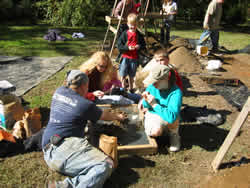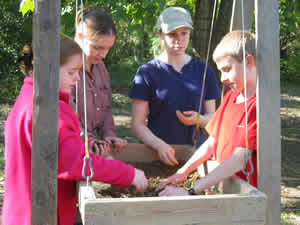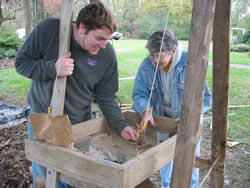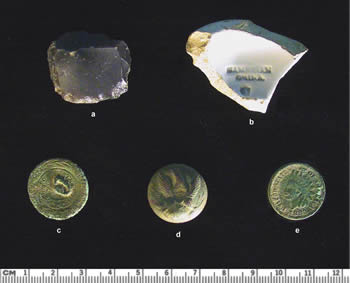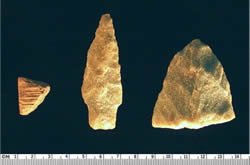October 2003
For one week at the end of October the W&MCAR conducted a public excavation at Weston Manor in conjunction with the statewide observance of Archaeology Month. Local residents were invited to either observe or participate as we explored the two building sites identified over the summer that flank Weston Manor. An estimated 21 people visited the excavation over the course of the week, most of whom were local school children.
Photos below: At least 21 volunteers participated in the Archaeology Month excavations, including a large group of local home-schooled children and Historic Hopewell Foundation enthusiasts like Patricia Lundquist (pictured top with William & Mary archaeologist Chris West).
The focus was on the western building site where seven additional test units were opened. These units were situated to trace the masonry foundation remnant and retrieve a sample of artifacts from which to date the building and understand activities associated with it. Traces of the foundation indicate the building measured at least 12 feet along the front side. A corner found in a smaller test unit to the north suggests a 12 foot square foundation. An early photograph suggests the building could have been larger though, perhaps with an extension resting on piers or posts.
Photos below: (left) A productive dig with the help of volunteers during Archaeology Month pinpointed three corners of the western outbuilding. Test Unit 7 revealed the southeast corner of the structure, defined by this builder's trench on the outer edge of the foundation. (right) This photograph shows the line of test units that exposed most of the southern edge of the structure.
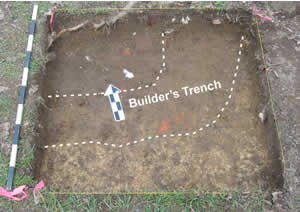
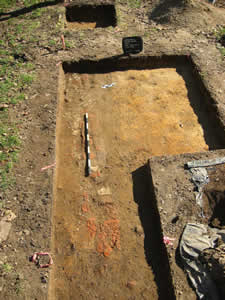
Most artifacts date from the 19th century but both earlier and later material was present. East of the building is a deposit rich in artifacts that seems to represent a general disposal area. Analysis of the artifacts and results is ongoing. Presently it would appear that this "dependency" building was mainly used prior to the Civil War for a variety of activities.
Photos below: (left) Historic-period artifacts from the additional test units range in date from the late 18th century through the late 19th century. The gunflint, pearlware ceramic sherd, and brass button (a—c) could be from the initial use of the property by the Gilliams. The maker's mark 'Cambrian China' traces the sherd's origin to a pottery in Wales, an unusual source at a time when England dominated the ceramics market in North America. Later artifacts include a General Services military button (d), most likely from the Civil War, and an 1883 'Indian Head' penny. (right) Excavations continued to document prehistoric Native American presence on the property. Notable artifacts (left to right) include cord-marked pottery (500 BC to AD 1600), a projectile point (3000 to 1200 BC), and an undated stone bifacial tool (sharpened on both sides).














